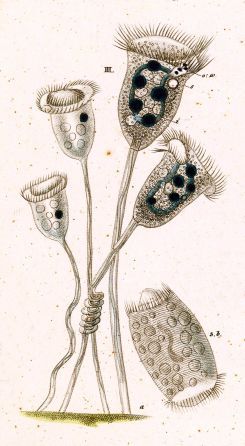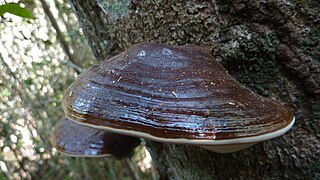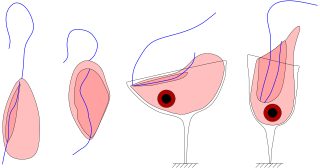Related Research Articles
A human pathogen is a pathogen that causes disease in humans.

Yersinia is a genus of bacteria in the family Yersiniaceae. Yersinia species are Gram-negative, coccobacilli bacteria, a few micrometers long and fractions of a micrometer in diameter, and are facultative anaerobes. Some members of Yersinia are pathogenic in humans; in particular, Y. pestis is the causative agent of the plague. Rodents are the natural reservoirs of Yersinia; less frequently, other mammals serve as the host. Infection may occur either through blood or in an alimentary fashion, occasionally via consumption of food products contaminated with infected urine or feces.
Aquifex pyrophilus is a gram-negative, non-spore forming, rod-shaped bacteria. It is one of a handful of species in the Aquificota phylum, which are a group of thermophilic bacteria that are found near underwater volcanoes or hot springs.
Mycobacterium phlei is a species of acid-fast bacteria in the genus Mycobacterium. It is characterized as one of the fast-growing mycobacteria. M. phlei has only occasionally been isolated in human infections, and patients infected with M. phlei generally respond well to anti-mycobacterial therapy. M. phlei has an unusually high GC-content of 73%.

Vorticella is a genus of bell-shaped ciliates that have stalks to attach themselves to substrates. The stalks have contractile myonemes, allowing them to pull the cell body against substrates. The formation of the stalk happens after the free-swimming stage.

Ganoderma tornatum is a fungal plant pathogen in the genus Ganoderma. It is a species of basidiomycete fungi in the family Polyporaceae. Members are also known as bracket fungi, or polypores.
Propionibacterium freudenreichii is a gram-positive, non-motile bacterium that plays an important role in the creation of Emmental cheese, and to some extent, Jarlsberg cheese, Leerdammer and Maasdam cheese. Its concentration in Swiss-type cheeses is higher than in any other cheese. Propionibacteria are commonly found in milk and dairy products, though they have also been extracted from soil. P. freudenreichii has a circular chromosome about 2.5 Mb long. When Emmental cheese is being produced, P. freudenreichii ferments lactate to form acetate, propionate, and carbon dioxide: (3 C3H6O3 → 2 C2H5CO2 + C2H3O2 + CO2).

Jakoba is a genus in the taxon Excavata, and currently has a single described species, Jakoba libera described by Patterson in 1990, and named in honour of Dutch botanist Jakoba Ruinen.
Thiovulum majus is a species of bacteria and a member of the phylum Campylobacterota. This sulfide-oxidizing species has been observed to swim at speeds as high as 615 micrometers per second, faster than those recorded for any other bacterial species.
Cristispira is a genus of bacteria of the spirochete phylum. They are known as large spirochetes. They are characterized by the host species in which they reside. They are known as harmless parasites of freshwater and marine molluscs and gastropods. They have an unusually large number of periplasmic flagella.
Arhodomonas aquaeolei is a species of the bacterial genus Arhodomonas noted for its ability to grow in an environment of high salinity. It is an aerobic, oval rod-shaped, gram-negative bacterium. It is motile by means a single polar flagellum.
Desulfurobacterium atlanticum is a thermophilic, anaerobic and chemolithoautotrophic bacterium from the family Aquificaceae. In 2006 it was isolated from marine hydrothermal systems and proposed to become a new bacterial species.
Halomonas meridiana is a bacterial species discovered in 1990 in the hypersaline lakes of Vestfold Hills, Antarctica.

Actinoplanes utahensis is a species of bacteria and a source of the drug acarbose, an alpha-glucosidase inhibitor used in the treatment of diabetes mellitus.
Panagrolaimus detritophagus is a terrestrial free-living nematode (roundworm). It has been reported in California, South America and Europe. It is the type species of the genus Panagrolaimus. In 2018, it, along with another nematode species became the first multicellular organism to be thawed back into a living state after prolonged cryopreservation. Pleistocene permafrost was obtained from the Kolyma River lowland, and thawed. The worms moved and ate after being thawed. They had been frozen for 30–40 thousand years, based on the age of that deposit.

The evolution of bacteria has progressed over billions of years since the Precambrian time with their first major divergence from the archaeal/eukaryotic lineage roughly 3.2-3.5 billion years ago. This was discovered through gene sequencing of bacterial nucleoids to reconstruct their phylogeny. Furthermore, evidence of permineralized microfossils of early prokaryotes was also discovered in the Australian Apex Chert rocks, dating back roughly 3.5 billion years ago during the time period known as the Precambrian time. This suggests that an organism in of the phylum Thermotogota was the most recent common ancestor of modern bacteria.
Helicobacter heilmannii sensu lato refers to a group of bacterial species within the Helicobacter genus. The Helicobacter genus consists of at least 40 species of spiral-shaped flagellated, Gram-negative bacteria of which the by far most prominent and well-known species is Helicobacter pylori. H. pylori is associated with the development of gastrointestinal tract diseases such as stomach inflammation, stomach ulcers, duodenal ulcers, stomach cancers that are not lymphomas, and various subtypes of extranodal marginal zone lymphomas, e.g. those of the stomach, small intestines, large intestines, and rectum. H. pylori has also been associated with the development of bile duct cancer and has been associated with a wide range of other diseases although its role in the development of many of these other diseases requires further study.
Gottschalkia acidurici is a species of bacteria belonging to the family of Gottschalkiaceae. It was formerly placed in the genus Clostridium of the Clostridiaceae. It can be anywhere between 2.5 and 4 micrometers in length and anywhere between 0.5 and 0.7 micrometers in width.

Planctomycetaceae is the only family in the order Planctomycetales within the Bacteria. Species within this family are mostly spherical, inhabiting a vast array of aquatic environments with the majority being in marine ecosystems. Planctomycetaceae species are generally aerobic, but are uniquely classified by fatty acid synthesis and stalk-like formations.

The Sheldon spectrum is an empirically-observed feature of marine life by which the size of an organism is inversely correlated with its abundance in the ocean. The spectrum is named after Ray Sheldon, a marine ecologist at Canada’s Bedford Institute of Oceanography in Dartmouth, Nova Scotia. Sheldon and colleagues first suggested the existence of the inverse correlation based on seagoing measurements of plankton made with a Coulter counter in the late 1960s, most notably during the first circum-navigation of the Americas aboard the CCGS Hudson.
References
- ↑ "Arhodomonas". List of Prokaryotic Names with Standing in Nomenclature. Retrieved 12 December 2018.
- 1 2 Tanner RS, Imhoff JF (2015). "Arhodomonas". Bergey's Manual of Systematics of Archaea and Bacteria. John Wiley & Sons. pp. 1–4. doi:10.1002/9781118960608.gbm01127. ISBN 978-1-118-96060-8.